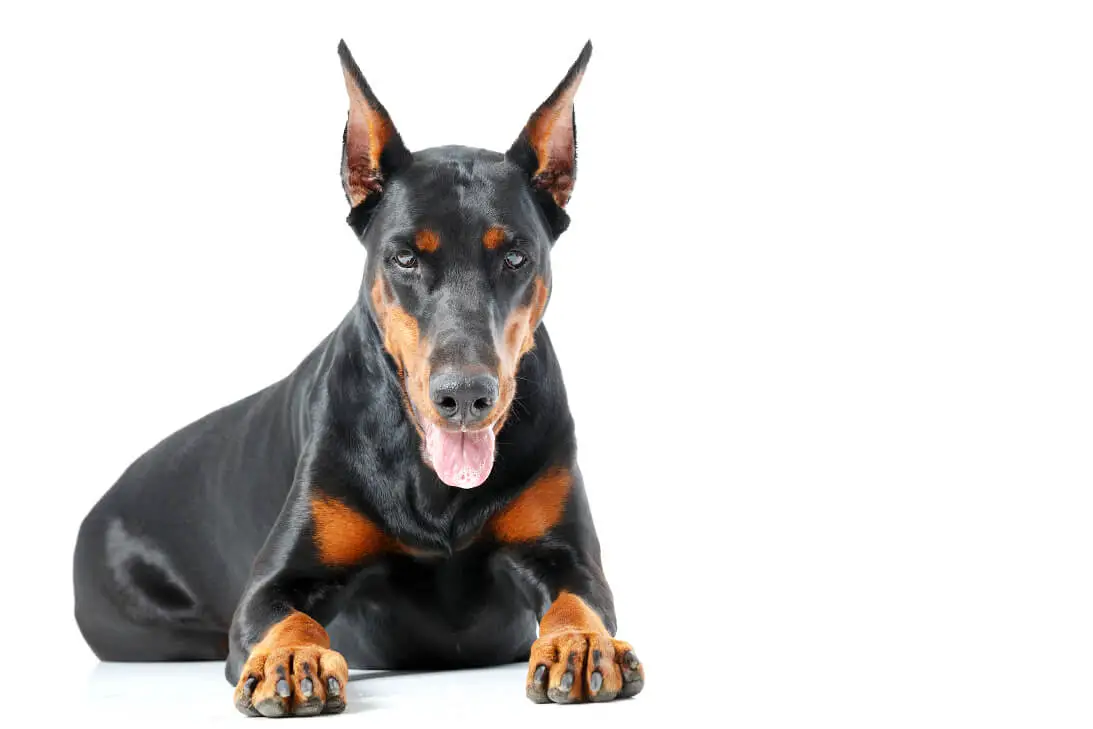Dobermans are an incredibly hard-working dog breed and they love having a task to do. To increase their stamina and muscles, a common exercise is making your Dobie carry weights on walks or hikes.
What Is The Maximum Weight a Doberman Can Carry?
A full-grown Doberman can carry up to 30% of their body weight, but, as a rule of thumb, your Doberman shouldn’t carry more than 25% of their weight. So, if your dog weighs 100 pounds, it is better to limit the weight to about 25 pounds. Old or very young dogs should carry less weight.
Backpacking With a Doberman
Dobermans need a lot of exercises, they’re great on hikes or long walks and since they have a strong pack instinct, they just love being near their human buddy at all times.
A backpacking trip with your Dobie is a wonderful activity and a great bonding experience. But backpacking also literally means carrying everything you need for a few days on your back. This is a shared burden though if your travel companion is a Doberman because he can haul his own camping gear.
However, there are some general rules to keep in mind before putting weights on a Doberman. In the following, we report some simple rules to get a stronger, healthier and happier Dobie.
Start Slow
To avoid injuries, it’s always good to start slow, even slower than you might think. For example, if you want your dog to start carrying weight on hikes in a backpack, start with going for a walk with an empty backpack, so your dog will start adjusting to the new situation. After a few hikes with an empty pack, you can start adding a bit of weight.
Make It a Fun Experience
Walking and hiking together is a great way to bond, as long as it’s a positive experience for both you and your dog. Never make exercise a chore. Doing so can be detrimental to your dog’s mental and physical state. Create positive feelings during your walks. Give your dog plenty of praise while exercising and make it a fun experience. If your dog isn’t excited about the walk, then you’ve done something wrong.
Pay Close Attention To Your Dog While Hiking:
Learn to “read” your dog emotions while they are walking and carrying weights. You should be able to tell when he’s pushing himself too far or he is in distress. Don’t ignore any sign. Any sudden changes in exercising or putting on a backpack, if they are foaming from the mouth, it there’s excessive panting, if they are shifting the weight favoring one leg over another, then there are some problems. When in doubt, stop the workout.
Overheating is a Serious Issue In Dobermans
Their sleek dark coat is beautiful, but it absorbs a ton of heat. As a consequence, Dobermans have issues with getting too hot. This goes back to the last point: pay close attention to your dog. Always provide plenty of water and if you suspect they are getting too hot, stop the walk and cool off in the shade, or spritz the head with some water.
Cold Weather Is Not Fun Either
Dobermans don’t do well in the cold. So if you are backpacking overnight with your Dobie, take extra precautions to keep him or her warm.
Check Their Paws Often
Create a habit to check your dog’s paws before, during, and after your hike. Paws often are the first place where damage can occur. Catching a cracked or damage pad early on helps prevent much worse problems later. Damage to your dog’s paws while hiking is very dangerous. If your 100-pound Doberman is limping because their paw has a bad cut while you’re five miles from your car, it’s important to have an antibiotic ointment and bandages with you.
Building muscles
In addition to some of these basic safety measures, it’s important to always allow plenty of recovery time. The way a dog’s body builds muscles is the same in which humans build muscles. As you work out, the muscle breaks down. As the body rests and is well nourished, it rebuilds in the places where the muscle is torn and will create a stronger and larger muscle than before.
This cycle of tearing and rebuilding muscles makes your Doberman bigger and more resistant. The downside is that, in case you don’t provide adequate recovery time, your Dobie’s body will not have time to rebuild the muscle. Essentially the body will be breaking the muscle again before it’s strengthened. To avoid muscle fatigue, provide at least two days off throughout the week to let your dog rest. Also try alternating workouts from one day to the next, so that you aren’t doing the same workout twice in a row, providing the muscles time to strengthen.
Packing gear
Most Dobermans are affectionate attention seekers. They are called Velcro dogs for a reason. When you are outdoors, they’ll typically stick very close by your side and won’t wander off at all. Nevertheless, when outdoor it’s always important to have a strong leash, an adequate collar or harness, and a lightweight but durable, water-resistant backpack. Make sure to bring a roll of dog waste bags to clean up after your dog as well.
Educate him
Basic obedience commands to teach your Doberman include “Sit”, “Stay”, “Come” and, crucially, “Leave it.” Teaching the “Leave it” command is particularly important for Dobies because they tend to eat non-food objects such as rocks. This command helps you control what your dog inspects and ingests by getting the dog to ignore the object on command. Save this command for after you teach your dog the “Sit” and “Stay” commands and keep your Doberman on a leash to prevent the dog from getting too near to the object. Place an object in front of your dog and give the “Leave it” command; if your dog ignores the item, give your Doberman a treat.


